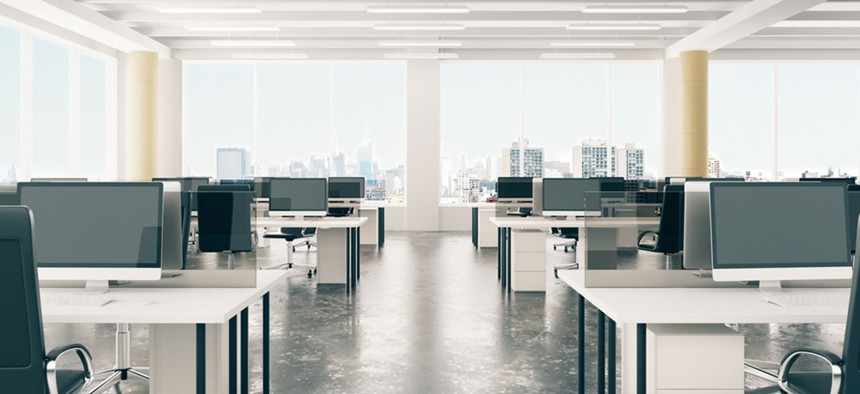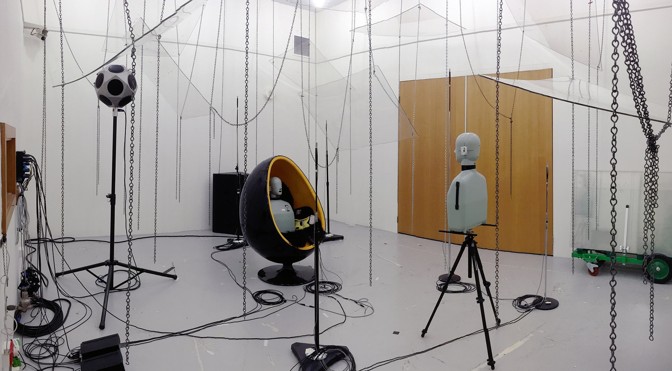
How to Make Your Open Office Less Annoying
Researchers are testing egg-shaped chairs, retroreflective ceilings, and other ways to help people concentrate without cubicles.
You know you’re in an open-plan office when you click on an article that will allow you to hate-read about open offices, then kind of hide your computer screen with the top half of your torso so that your colleagues don’t realize just how much you’re not a team player.
You know you’re in an open office because you’re trying to write a sensitive email while wedged between one coworker making a gynecologist appointment and another picking tuna-fish salad out of his Invisalign.
The office’s openness is never more real to you than when you try to have a private conversation with the intern about the office dress code, only to further expose the entire office—to a lesson in micro-generational social norms and the definition of a “cold-shoulder top.”
Around 70 percent of offices in the United States are open-concept, according to the BBC, even though these paper-pushing panopticons make us more likely to get sick, and make us less likely to be ... uh, what was I saying ... productive. Because of all the distractions.
But now, science might have an answer, sort of, in the form of chairs shaped like eggs and ceilings that bounce your own squawks back at you, forcing you to quiet down through a trick of acoustic psychology.

Manuj Yadav / University of Sydney
This comes to us from, as the press release notes, “researchers in Australia, who’ve discovered that open-plan spaces could benefit from additional specialized and local acoustic treatments.”
Specifically, one Australian researcher, the University of Sydney’s Manuj Yadav, will be presenting his team’s ideas for muffling the chattering, sneezing, ringing, pinging, and circling back of open-office life at this week’s Acoustical Society of America meeting in Minneapolis. First, there’s an egg-shaped chair, meant to protect the person ensconced within from the racket outside. There’s also a plywood “retroreflective ceiling,” which reflects sound back toward the speaker, making the person sound louder to him or herself and thus encouraging them to speak at a lower volume. (The reverse happens when you try to talk while wearing headphones—you sound quieter to yourself and overcompensate.) Today, most offices use an “absorptive” surface that sucks in sound, Yadav says, but retroreflective coatings would help reduce the overall office-noise level.
The chairs, too, encourage talkers to reduce their volume levels, Yadav says, by projecting the speaker’s voice toward the front, at whomever they’re speaking to. The chairs could be used all the time or just in busy open spaces, he says.
Yadav and his colleagues tested these coatings and chairs by using dummies that have microphones for ears and loudspeakers for mouths. They then measured how much the devices muffled the sound the dummies (and the people around them) were hearing. They don’t yet know exactly how much the retroreflective ceilings work to reduce sound, but they found that the chairs blocked external noise by about 10 decibels, or about the effect of cupping your hands over your ears. But they hope that, using their research, other manufacturers can make chairs that do an even better job.
This is all part of the mostly fruitless search for a technology that might make open offices less miserable. For example, some researchers are looking into “natural” white-noise sounds, like flowing water, to muffle office sounds, or large, felt “isolation cones” that would hang from the ceiling and provide temporary privacy.
The furniture company Steelcase makes a variety of free-floating glass cubes meant for private meetings in the middle of open-plan offices. But you can’t simply claim one as your personal office, British-explorer-in-Antarctica style, which diminishes its appeal.
These devices, however imperfect, will have to do for now. At least when the robots take our jobs they will have to take our open offices, too.






